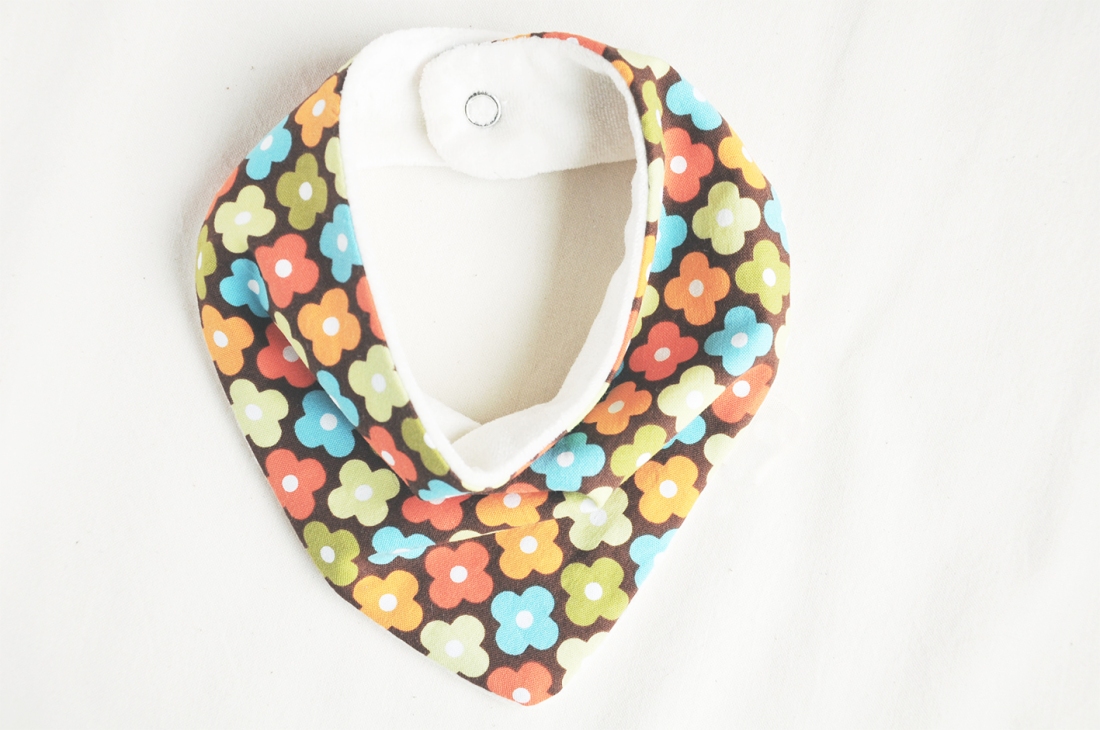The bandana bib is that must have item for new babies, and an excellent way to start fearless sewing. It was the first product on my etsy shop, and it inspired my search for the best fabrics for drooling babies. So, I thought it would be interesting to share the pattern I created for these bandanas, as well as my experience with my favorite fabrics for sewing it.
The pattern comes in 3 sizes, fitting most babies from newborn to 24 months. You can download the full tutorial and pattern in this link:
Bandana Bib e-Book
1.
First you need to choose the fabrics (you will need one fat quarter of each). This bib is made of cotton front (weaved or knit), and absorbent back. Depending on the absorbent fabric you choose, you may add an extra lining (flannel or jersey) to increase absorption. This is also a great opportunity to use some of your scraps. Next I describe the fabrics I like to use.
FRONT: If you are a beginner I advise using some lightweight weaved cotton fabric. It also looks great (and super comfy) with jersey fabrics, but these can be tricky to sew if you are untrained.

BACK: There are several absorbent/stay dry fabrics in the market. I like to use terry (cotton or bamboo), or organic bamboo velour, because these are fabrics with great stay dry properties. Most times I use organic bamboo velour (picture below), which is my favorite absorbent fabric, for its suppleness and stay dry feeling. It is not as thick as most terry, so I add it some lining fabric. Also, bamboo velour is a knit, great if you are sewing with front in jersey. Sometimes I also use jersey for the back. It is not as absorbent as the other two, but it has a nice fit to the babies neck.

LINING: You may add a layer of cotton flannel or fleece fabric (you may choose from diverse natural fibers such as cotton, bamboo or hemp) to increase absorption. If using knits only, choose a piece of jersey. If your back/absorbent fabric is thick, don’t use lining as it will reduce comfort around the baby’s neck.

WATERPROOF lining – usually I don’t use synthetic fabrics in babies cloth, but, if you need to (some babies really drool !!, I know, I had two ♥♥) you may choose a waterproof fabric for the lining. The most common, child/baby approved, is PUL (polyester/polyurethane laminated knit fabric). When choosing a waterproof/synthetic fabric, please search for information about it’s health safety standards for babies.
2.
Second you need the pattern you downloaded. Print and assemble it.
Place it over your fabrics to trace and cut (seam allowances are already included). Transfer all marks, (also mark top and bottom fold).

3.
Now sew the fabrics together with a regular straight stitch (if using all knit fabrics use a zig zag stitch): place front and back fabrics with right sides facing together. Place the lining (if using this) under it.

Align the three fabrics and sew around leaving a 5cm (2 in) gap.

Turn your fabric inside out and sew the gap with a blind stitch (sew by hand). Topstitch all around and place snaps or velcro.

The e-book contains a tutorial with more detailed information. Feel free to ask any questions you might have. Have fun sewing, mixing and matching cute colors. I would love to see your creations if you feel like sharing it.
